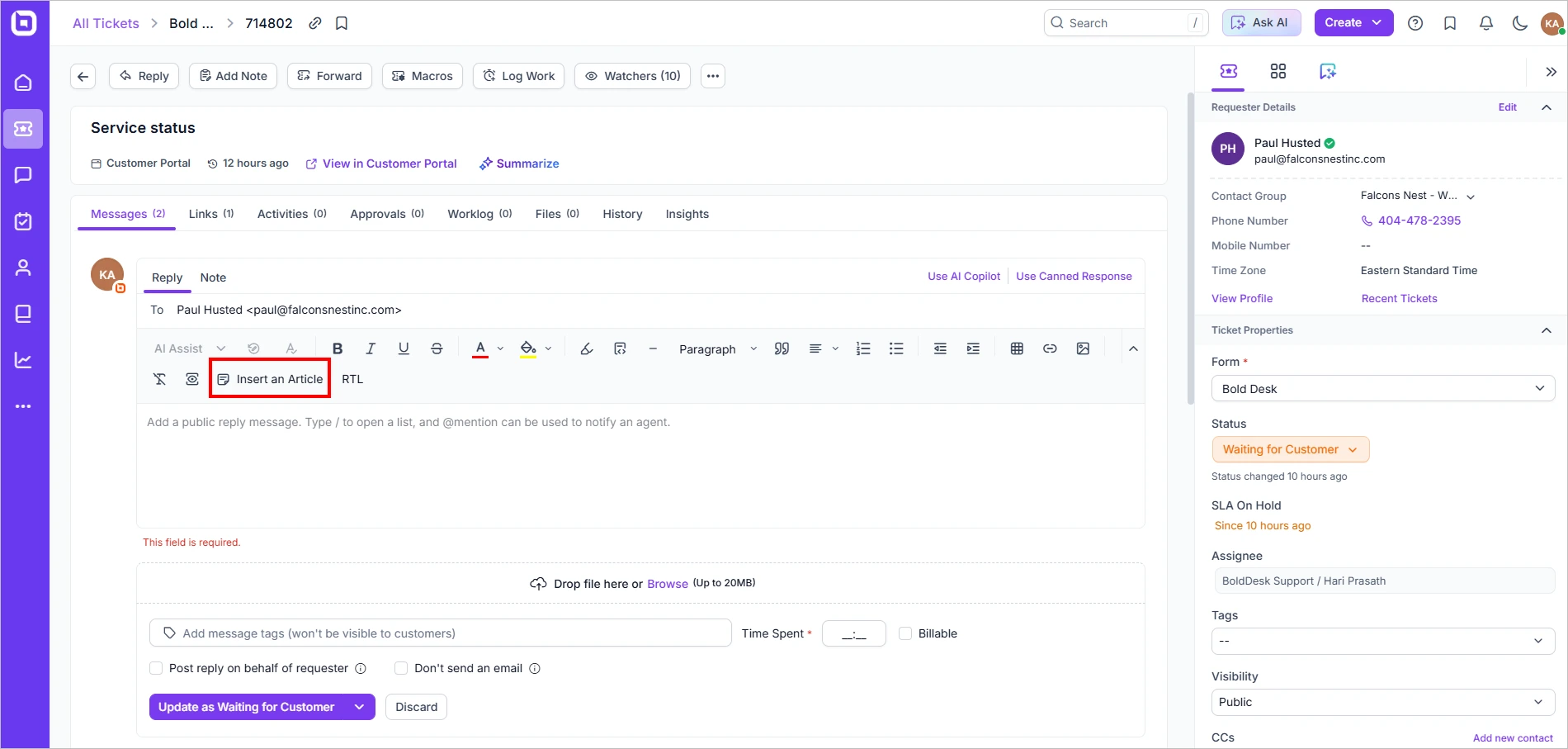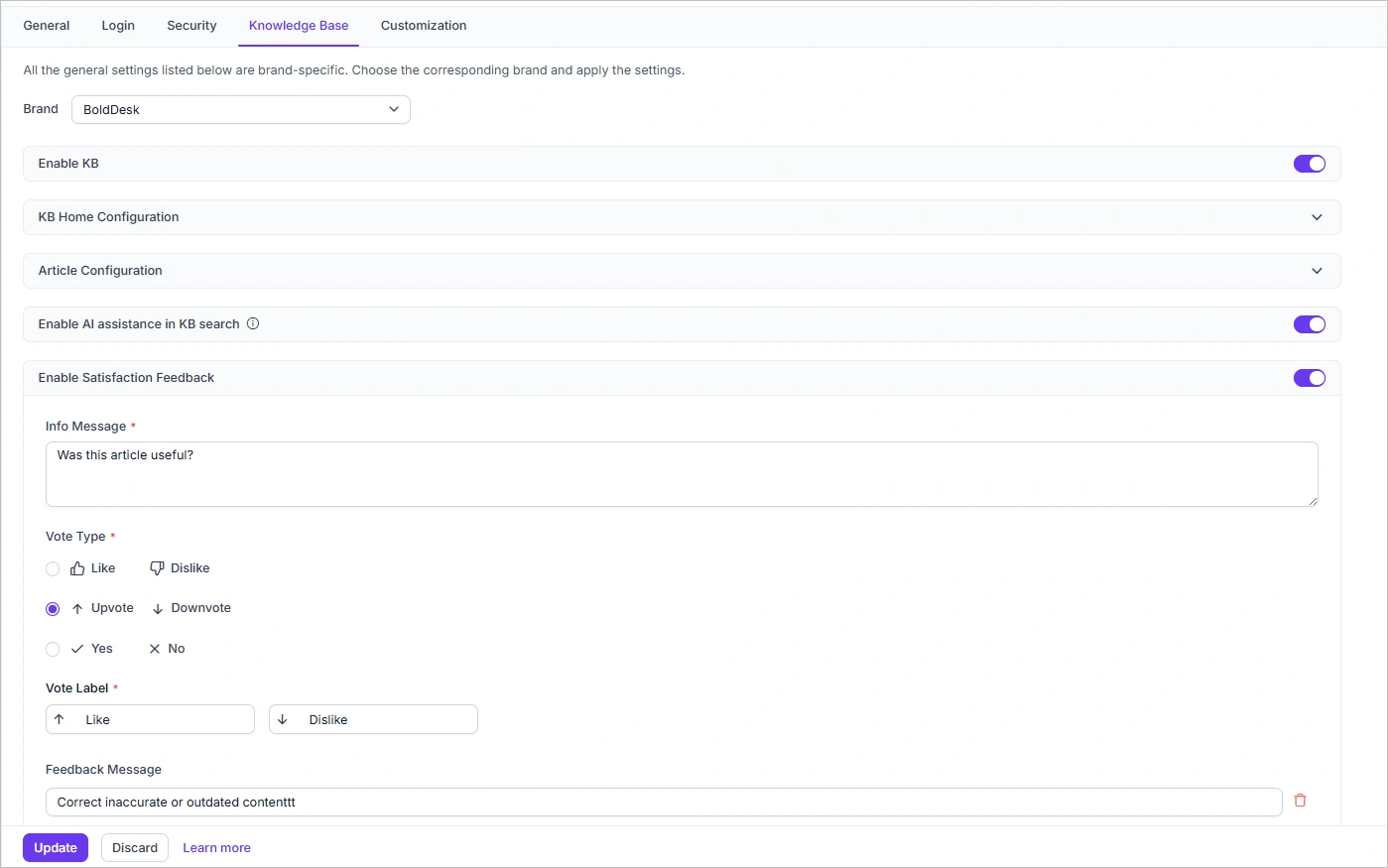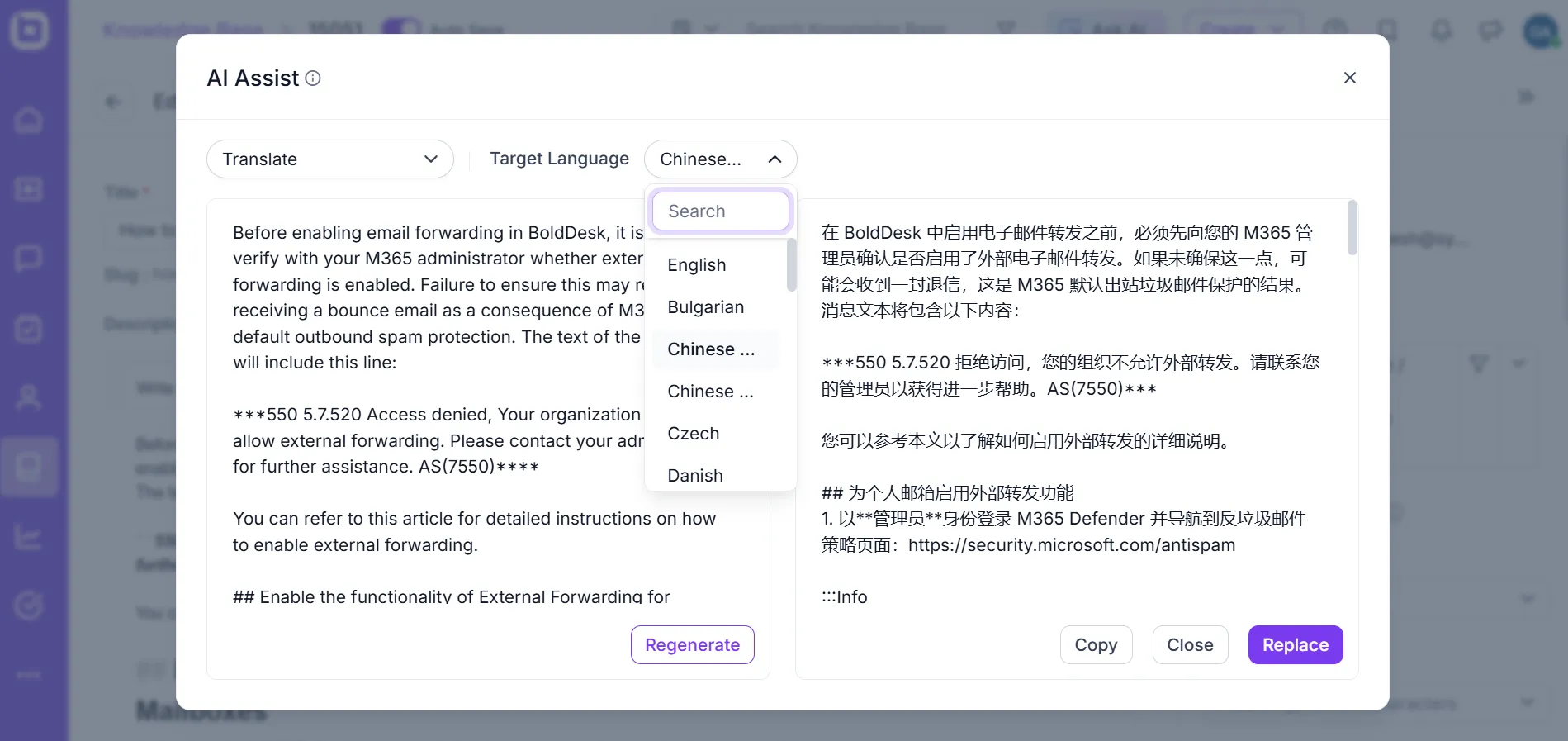Provide valuable information to customers and employees using knowledge base software to benefit your customer service.
A study suggests that if a knowledge base for self-service support is available, 92% of people claim they would use it.
Allow your customers and support team to access relevant, up-to-date information that will ease the resolution process when they encounter issues with the products or services from your company.
In this article, learn what a knowledge base is in detail and how implementing these self-service portals can benefit your business.
What is a knowledge base?
A knowledge base is a central storage location for information: a digital library, a database of related information about a particular subject, and a means to provide or collect knowledge from various sources.
These knowledge base management platforms help in gathering, organizing, retrieving, and sharing this information.
It is used in organizations as a data repository that serves as a self-service platform for both employees and customers.
These centralized data repositories include details about a company’s products, its features, and how-to information on using them.
Types of knowledge base
There are two types of these self-service tools:
- Internal
- External
Internal knowledge base
An internal knowledge base is a database of your company’s systems and procedures for your employees’ reference.
It includes all the essential details about your company’s customers, products, and services.
It especially includes troubleshooting to help your support team. It also has information like employee handbooks and annual reports that your employees can reference for their own knowledge.
An internal knowledge base management portal consists of articles with the following types of information:
- Company guidelines.
- Employee roles and contact list.
- Company metrics.
- Training resources.
- Documentation.
- Forms, templates, branding info.
- Customers project details.
External knowledge base
An external self-service platform is a database built for customers’ reference.
It generally consists of all the necessary information about a company and its products or services.
An external knowledge base management tool can comprise of:
- Troubleshooting and FAQs.
- Billing and pricing.
- Contact information.
- Licensing specifics.
- Company description (About Us page).
- Product descriptions.
- Locations of shops or offices.
What is the purpose of a knowledge base?
A knowledge base serves as a central storage location for information. Its purpose is to:
- Provide a means of information management: It organizes large amounts of information in a coherent and usable way.
- Facilitate easy access to information: It allows users to search for the information they need quickly and easily.
- Improve productivity and efficiency: Employees can use the knowledge base to find information necessary for their tasks quickly, thereby enhancing their efficiency and decreasing time spent searching for information.
- Be a resource for training and learning: It can be used as a tool for training new employees or educating current ones about new processes or tools. It can also help lower the costs of agent onboarding and training, as new employees can self-learn through relevant content.
- Store structured and unstructured information: This includes data, rules, and relationships relevant to an organization.
- Enhance customer support: In customer service, a knowledge base can provide customers with easy access to answers for common questions or issues.
- Encourage knowledge sharing: It can foster an environment of collaboration and knowledge sharing among employees or team members.
- Offer 24/7 self-service: Providing external knowledge bases is a cost-efficient method to offer 24/7 customer service. Instead of increasing your staff or making them work nonstop, you can empower customers to find their own solutions.
How to make good knowledge base articles
A knowledge base’s setup doesn’t have to be difficult. The following are the steps to creating a useful knowledge base:
1. Establish the purpose of your knowledge base
Before starting to draft the articles for the knowledge management system, you need to establish its purpose.
First, does your company actually need the software? Do you need it for your clients, agents or both?
To figure out the solution that is best for you, answer the following questions:
- Are there a lot of questions frequently asked by your customers?
- Are there a variety of resources your employees often reference to solve customer problems?
- Is your customer service overburdened with a lot of customer inquiries?
- How fast is your customer service at responding to queries, and is the demand changing?
- Does any agent of your customer support team possess expertise or knowledge that would be lost if they left the company?
2. Identify the basic components of your knowledge base
You need to identify your basic components before making the self-service portal. The following are some essential components to include in it:
a. Contact support link
Regardless of how robust your knowledge base management platform is, it won’t help customers who need additional assistance or can’t locate what they’re looking for.
Therefore, you need to include a link and instructions on how to contact your support team.
b. Search bar
Customers usually enter your knowledge repository with a specific topic in mind. Therefore, you need to give them a search bar to navigate to their issue in the shortest time possible.
c. FAQ section
The frequently asked questions page is the first place most customers will navigate to if they have a simple query about your product or service.
Therefore, you need to organize this section by topic to ease your customer’s work while searching for info.
3. Prepare the structure of your knowledge base
A knowledge base design should be user-friendly and easy to understand. Therefore, you need to organize knowledge base content and make it easy for your customers to search for and browse through the articles.
Proactively create an ideal framework that best fits your audience’s needs and interests.
4. Do extensive research and knowledge base content preparation
You need to prepare an outline of every topic you intend to cover and keep a record for the content production process.
Note the content you already have and any gaps that need to be filled.
In addition, discuss with your support, sales, and marketing teams the common questions that clients always ask. Add their answers as solution articles for future reference.
5. Integrate your self-service tool with your help desk software
After creating a knowledge base, you need to integrate it with your help desk software to make it function better.
A help desk has useful features like a powerful search function, permissions settings, and methods for better organization like tags.
In addition, you can track how your tool is used, like which articles have the most visits.

6. Set user access levels
When you’ve taken care of all these issues, your self-service software is now ready.
You must then choose who gets access to your documents. For instance, you can provide some agents editing privileges while limiting others to read-only or write-only access.
Setting access levels will protect it from unwanted alterations, thus making it safe for customers and agents to use.
Knowledge base management & best practices
After creating the content of the articles, you can maintain their standards through the following best practices:
Obtain consumer feedback
You can enhance customer satisfaction and build stronger customer relationships by considering the feedback and implementing changes accordingly. This will keep you informed of missing content in your KB.

Look through your content
Establish intervals at which to review the content in articles. You can add new content, make changes to existing articles where necessary, and remove outdated information.
Check accessibility
Make sure your knowledge base management software is accessible. Ensure you consider the user experience when creating new knowledge base articles. They should be user-friendly.
Engage your customer service team
As customers’ main point of contact, this team will have the best idea of gaps in your knowledge base and how to fill them. Give them the ability to do so.
Make it simple for your customers to easily reach your support team
Do not make your self-service tools a barrier that keeps clients from reaching your customer service agents. It will never contain the answer to every question.
Benefits of using a knowledge base in your customer service
A study by Higher Logic Vanilla indicate that 79% of individuals anticipate that organizations will offer self-service support tools, enabling customers to find solutions without needing to reach out to support.
Having a knowledge base in your customer service system is advantageous.
External knowledge base benefits for clients
Implementing an external knowledge base can offer several benefits for clients, enhancing their experience and satisfaction with a product or service.
24/7 access to information
Clients can access the knowledge base at any time, regardless of business hours or time zones. This means many of them can find answers to their questions and solutions to their problems instantly, without having to wait for support staff to be available.
Self-service support
A well-organized knowledge base lets clients troubleshoot issues and find answers on their own, reducing their dependence on customer support teams. This not only saves time for both the client and the company but also fosters a sense of independence.
Consistency and accuracy of information
With an external knowledge base, clients receive standardized information, which ensures that the guidance they receive is consistent and accurate, reducing confusion and potential errors that can arise from agents miswording answers or accidentally leaving out details.
Improved client satisfaction
By offering clients a convenient and reliable source of information, a well-maintained knowledge base enhances their overall satisfaction with the company. Customers feel supported and able to overcome challenges independently, leading to greater retention.
Faster problem resolution
Clients can quickly locate relevant articles, tutorials, or guides within the knowledge base to address their specific issues or concerns. This accelerates the problem-solving process and minimizes wait time for agents to attend to them, leading to improved productivity and shorter ticket resolution times.
Multilingual support
A multilingual knowledge base can extend your reach to a global audience and ensure everyone can access the information they require in their preferred language.

Comprehensive information
A well-structured knowledge base can offer extensive information on products or services, including FAQs, troubleshooting guides, how-to articles, and instructional videos. This helps clients understand the products or services better and use them more effectively.
Internal knowledge base benefits for employees
Implementing an internal knowledge base offers employees better productivity, collaboration, and knowledge sharing within an organization.
Efficient onboarding and training
New employees can quickly get up to speed by accessing the knowledge base for training materials, onboarding resources, and procedural documentation. This accelerates the onboarding process and ensures consistency in training across different teams or departments.
Collaboration and knowledge sharing
Employees can contribute their expertise and insights by creating and sharing knowledge base articles, FAQs, and troubleshooting guides. This encourages collaboration and knowledge sharing across teams and departments, contributing to a culture of teamwork.
Empowerment of employees
By having easy access to information, employees are empowered to make decisions and solve problems without constant supervision or intervention from management.
Improved efficiency and productivity
Employees can quickly find information or solutions to problems without having to ask colleagues or wait for responses from support teams. This reduces downtime and allows employees to complete tasks more efficiently.
Consistency in information
Having a single source of information ensures that all employees have access to the same, up-to-date information. This consistency helps in maintaining the quality of work and reduces misunderstandings or errors that may arise from outdated or incorrect data.
Reduced workload for support staff
With a comprehensive knowledge base, employees can find answers to common questions without needing to contact specific departments, like IT. This reduces the workload on those teams, enabling them to concentrate on more complex queries and tasks.
Maximize efficiency with a feature-rich knowledge base
I hope you have a better idea of what a knowledge base is, its importance, and how to make good self-help articles.
Shorten your support team’s resolution time with knowledge bases.
BoldDesk® is equipped to help you perfect your self-help tool with great article templates and customer service tools with a wealth of useful features.
To witness how BoldDesk can boost your support team’s performance, register for a free trial.
If you need further clarification, don’t hesitate to reach out to the BoldDesk support team.
For a first-hand experience of BoldDesk’s functionality and customization possibilities to match your business needs, get in touch with us to schedule a live demo.
Related articles



 Email Ticketing System
Email Ticketing System



